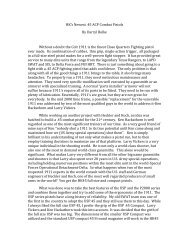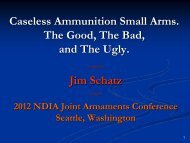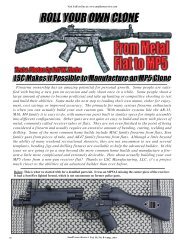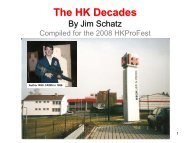DO WE NEED A NEW SERVICE RIFLE CARTRIDGE? - HKPro.com
DO WE NEED A NEW SERVICE RIFLE CARTRIDGE? - HKPro.com
DO WE NEED A NEW SERVICE RIFLE CARTRIDGE? - HKPro.com
You also want an ePaper? Increase the reach of your titles
YUMPU automatically turns print PDFs into web optimized ePapers that Google loves.
5.56 NATO ROUNDTABLE JIM SCHATZ<br />
Conference in Dallas U.S. Army PM-Soldier<br />
Weapons Majors Shawn Murray and<br />
Elliot Caggins briefed the results of a survey<br />
conducted during 2 weeks in Afghanistan<br />
in 2010 wherein <strong>com</strong>bat troops stated,<br />
“One of 8 key focus areas the troops<br />
stated needed urgent effort on was 5 - increased<br />
firepower (caliber) at extended<br />
ranges,” and wanted more 7.62x51mm<br />
MK48 LMG’s to replace 5.56x45mm<br />
M249 SAWs to deal with both protected<br />
and long range targets.<br />
26. At this same May 2010 NDIA conference<br />
the U.S. Army ARDEC (Armaments<br />
Research, Development and Engineering<br />
Center headquartered at Picatinny Arsenal,<br />
NJ) Program Manager for the LSAT<br />
(Lightweight Small Arms Technologies)<br />
program once again briefed that the current<br />
LSAT ammunition, LMG and new<br />
LSAT Carbine system architecture was<br />
a “scalable design” and open to and had<br />
been modeled for a “larger caliber” alternative<br />
to the current 5.56x45mm prototypes<br />
(6.5mm had been discussed in public<br />
the forum previously).<br />
27. A confidential unreleased study and<br />
test report prepared by the U.S. Army AR-<br />
DEC on an optimum assault rifle cartridge<br />
identified not 5.56x45mm as the optimum<br />
assault rifle cartridge but one within the<br />
6.5mm-6.8mm range.<br />
28. The majority of states in America do<br />
not allow cartridges under .25 caliber to<br />
be used for deer hunting, to include .223<br />
Remington and 5.56x45mm rounds even<br />
with enhanced non-Hague <strong>com</strong>pliant<br />
hunting-style (deforming) projectiles.<br />
29. The Communist Chinese developed<br />
and have since fielded an entire family of<br />
5.8mm ammunition (specifically to outperform<br />
the 5.56x45mm NATO round) and<br />
weapons versus the traditional Chinese<br />
Communist practice of fielding the service<br />
rifle cartridge of Russia, e.g. the inferior<br />
5.45x39mm round. The Chinese consider<br />
the 5.8mm caliber family of weapons to<br />
be so effective and superior to the weapons<br />
chambered in the 5.56x45mm NATO<br />
round that they do not export this technology<br />
to other customer states.<br />
30. One of the prime conclusions of the<br />
December 2009 NSWC Crane-<strong>com</strong>piled<br />
test report entitled Comparison of Terminal<br />
Ballistic Performance of M855,<br />
MK318, 115 gr. 6.8 SPC and MK319 concluded<br />
that the M855 in its current NATO<br />
SS109-style loading was inferior in many<br />
important regards to include accuracy,<br />
short range (CQC) and 100 yard terminal<br />
effects, a tendency for through and<br />
through over penetration and inferior<br />
barrier penetration. It is worth noting<br />
that the medium-caliber 6.8x43mm Rem.<br />
SPC round included in this test report was<br />
tested not with the BTB (Blind to Barrier)<br />
SOST projectiles used in the MK318 and<br />
MK319 SOST rounds tested but with a<br />
conventional OTM (Open Tip Match) bullet<br />
and thus would likely have performed<br />
far better with the SOST projectile when<br />
<strong>com</strong>pared to the 5.56x45mm SOST and<br />
M855 rounds tested.<br />
31. The factual contents of the excellent<br />
monograph written by U.S. Army Major<br />
Thomas P. Ehrhart entitled Increasing<br />
Small Arms Lethality in Afghanistan;<br />
Taking back the Infantry Half-Kilometer<br />
discusses the unsuitability of the SS109-<br />
style 5.56x45mm cartridge in modern<br />
warfare, in particular in the long-range<br />
war in Afghanistan. Key observations<br />
and conclusions in this excellent study<br />
include, “Small caliber high velocity<br />
rounds are especially dependent on this<br />
instability (yawing) for their lethality.<br />
For the M855 cartridge, maximum stability<br />
is from 150 meters out to 350 meters<br />
and it is therefore potentially less<br />
lethal between these two ranges.” Major<br />
Ehrhart goes on to state, “With the recent<br />
halt in production of the M855A1 cartridge<br />
(2nd iteration M855A1 ‘Lead Free<br />
Slug’ {LFS} variant), which designers<br />
promised would deliver this effectiveness<br />
(enhanced terminal effectiveness),<br />
it appears all options within this caliber<br />
have been exhausted.” On the subject<br />
of training as it relates to hit probability<br />
of the rifleman, Major Ehrhart states<br />
that, “The limited capability of the current<br />
M855 cartridge <strong>com</strong>bined with the<br />
extended distances of engagements in<br />
Afghanistan requires that shot placement<br />
on target is more critical than ever<br />
before.” And on page 28 of this document<br />
Major Ehrhart recounts the factual<br />
report about when, “Lieutenant Colonel<br />
David H. Petraeus (then current 4-star<br />
Commander of the International Security<br />
Assistance Force (ISAF) and U.S. Forces<br />
in Afghanistan) was shot in the chest by<br />
an M855 round from an M249 squad automatic<br />
weapon. He walked out of the<br />
hospital several days after the accident.”<br />
Major Ehrhart also provides more than<br />
100 references and documents, official<br />
and otherwise to support of the conclusions<br />
and statements on this subject as<br />
contained in this monograph.<br />
32. From December 2006 through May<br />
2007 the U.S. DoD Technical Support<br />
Working Group (TSWG) conducted an<br />
interagency/international assessment of<br />
various medium-caliber MURG upper<br />
receivers to improve the terminal effects<br />
of 5.56x45mm M4-style platforms. These<br />
extensive user tests documented that such<br />
a drop-on medium-caliber conversion<br />
was feasible and effective in nearly doubling<br />
the terminal effects of the short-barrel<br />
10-14.5 inch barreled carbine. It was<br />
also discovered that operators were able<br />
to engage targets with equal or better accuracy<br />
when <strong>com</strong>pared with 5.56x45mm<br />
platforms. The additional recoil impulse<br />
of the more powerful 6.8x43mm Rem.<br />
SPC cartridge when <strong>com</strong>pared to identical<br />
platforms in 5.56x45mm did not degrade<br />
the ability of the test personnel to rapidly<br />
engage multiple targets – in practice<br />
both calibers were identical contrary to<br />
<strong>com</strong>mon myth. From a <strong>com</strong>pact carbine<br />
a medium-caliber COTS MURG option<br />
delivers 56-77% heavier and 24% larger<br />
frontal surface area projectiles and two<br />
times the projectile mass to the target,<br />
as well as a 33% increase in muzzle energy<br />
when <strong>com</strong>pared to even the very best<br />
5.56x45mm cartridges, and at no degradation<br />
of hit probability even in rapid fire.<br />
To no ones surprise ballistic gelatin testing<br />
performed by the FBI, the USMC, and<br />
other agencies within the U.S. DoD with<br />
both calibers employing similar projectile<br />
designs reveal far greater permanent and<br />
temporary wound cavities for the larger,<br />
heavier projectiles.<br />
33. Re<strong>com</strong>mendations to the troops from<br />
the U.S. Army Infantry Center and School<br />
at Fort Benning (recently <strong>com</strong>bined with<br />
Colombian marines armed with 5.56 mm Galil assault rifles raid a building while participating in amphibious beach assault training during Southern Exchange<br />
and Partnership of the Americas 2010 in Ancon, Peru, July 24, 2010. The exercise is designed to enhance cooperative partnerships with maritime forces<br />
from Argentina, Mexico, Peru, Brazil, Uruguay, Colombia and the United States. (U.S. Marine Corps photo by Cpl. Brian J. Slaght/Released)<br />
126 SPRING 2011 SPRING 2011 127






